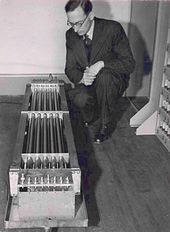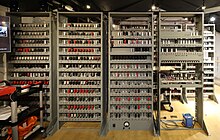
The history of computing hardware covers the developments from early simple devices to aid calculation to modern day computers.

The LEO was a series of early computer systems created by J. Lyons and Co. The first in the series, the LEO I, was the first computer used for commercial business applications.
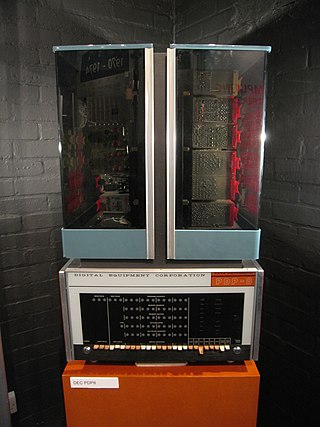
The PDP-8 is a family of 12-bit minicomputers that was produced by Digital Equipment Corporation (DEC). It was the first commercially successful minicomputer, with over 50,000 units being sold over the model's lifetime. Its basic design follows the pioneering LINC but has a smaller instruction set, which is an expanded version of the PDP-5 instruction set. Similar machines from DEC are the PDP-12 which is a modernized version of the PDP-8 and LINC concepts, and the PDP-14 industrial controller system.
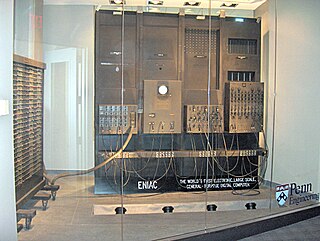
ENIAC was the first programmable, electronic, general-purpose digital computer, completed in 1945. Other computers had some of these features, but ENIAC was the first to have them all. It was Turing-complete and able to solve "a large class of numerical problems" through reprogramming.

The LINC is a 12-bit, 2048-word transistorized computer. The LINC is considered by some to be the first minicomputer and a forerunner to the personal computer. Originally named the Linc, suggesting the project's origins at MIT's Lincoln Laboratory, it was renamed LINC after the project moved from the Lincoln Laboratory. The LINC was designed by Wesley A. Clark and Charles Molnar.

Sir Maurice Vincent Wilkes was an English computer scientist who designed and helped build the Electronic Delay Storage Automatic Calculator (EDSAC), one of the earliest stored program computers, and who invented microprogramming, a method for using stored-program logic to operate the control unit of a central processing unit's circuits. At the time of his death, Wilkes was an Emeritus Professor at the University of Cambridge.
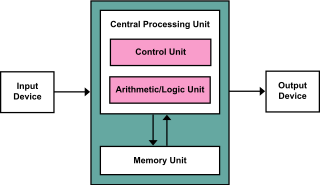
The von Neumann architecture—also known as the von Neumann model or Princeton architecture—is a computer architecture based on a 1945 description by John von Neumann, and by others, in the First Draft of a Report on the EDVAC. The document describes a design architecture for an electronic digital computer with these components:

The Manchester Baby, also called the Small-Scale Experimental Machine (SSEM), was the first electronic stored-program computer. It was built at the University of Manchester by Frederic C. Williams, Tom Kilburn, and Geoff Tootill, and ran its first program on 21 June 1948.

The Department of Computer Science and Technology, formerly the Computer Laboratory, is the computer science department of the University of Cambridge. As of 2023 it employed 56 faculty members, 45 support staff, 105 research staff, and about 205 research students. The current Head of Department is Professor Alastair Beresford.
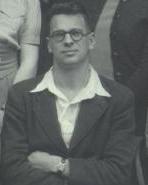
David John Wheeler was a computer scientist and professor of computer science at the University of Cambridge.
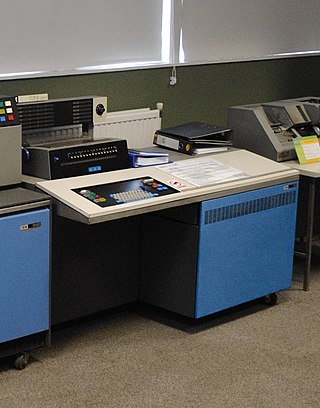
The IBM 1130 Computing System, introduced in 1965, was IBM's least expensive computer at that time. A binary 16-bit machine, it was marketed to price-sensitive, computing-intensive technical markets, like education and engineering, succeeding the decimal IBM 1620 in that market segment. Typical installations included a 1 megabyte disk drive that stored the operating system, compilers and object programs, with program source generated and maintained on punched cards. Fortran was the most common programming language used, but several others, including APL, were available.
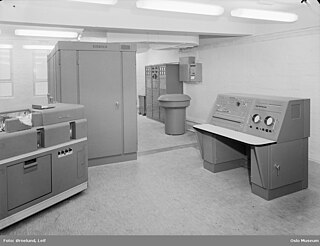
The DEUCE was one of the earliest British commercially available computers, built by English Electric from 1955. It was the production version of the Pilot ACE, itself a cut-down version of Alan Turing's ACE.
The APE(X)C, or All Purpose Electronic (X) Computer series was designed by Andrew Donald Booth at Birkbeck College, London in the early 1950s. His work on the APE(X)C series was sponsored by the British Rayon Research Association. Although the naming conventions are slightly unclear, it seems the first model belonged to the BRRA. According to Booth, the X stood for X-company.
Autocode is the name of a family of "simplified coding systems", later called programming languages, devised in the 1950s and 1960s for a series of digital computers at the Universities of Manchester, Cambridge and London. Autocode was a generic term; the autocodes for different machines were not necessarily closely related as are, for example, the different versions of the single language Fortran.

A computer is a machine that can be programmed to automatically carry out sequences of arithmetic or logical operations (computation). Modern digital electronic computers can perform generic sets of operations known as programs. These programs enable computers to perform a wide range of tasks. The term computer system may refer to a nominally complete computer that includes the hardware, operating system, software, and peripheral equipment needed and used for full operation; or to a group of computers that are linked and function together, such as a computer network or computer cluster.

The Elliott 803 is a small, medium-speed transistor digital computer which was manufactured by the British company Elliott Brothers in the 1960s. About 211 were built.

The Manchester Mark 1 was one of the earliest stored-program computers, developed at the Victoria University of Manchester, England from the Manchester Baby. Work began in August 1948, and the first version was operational by April 1949; a program written to search for Mersenne primes ran error-free for nine hours on the night of 16/17 June 1949.
In computer programming, a function, subprogram, procedure, method, routine or subroutine is a callable unit that has a well-defined behavior and can be invoked by other software units to exhibit that behavior.
The Wheeler Jump is a type of subroutine call methodology that was used on some early computers that lacked hardware support for saving the return address. The concept was developed by David Wheeler while working on the pioneering EDSAC machine in the 1950s. EDSAC had not been built with subroutines in mind, and lacked a suitable processor register or a hardware stack that might allow the return address to be easily stored.
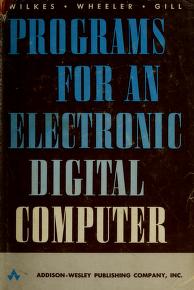
The Preparation of Programs for an Electronic Digital Computer was the first book on computer programming. Published in 1951, it was written by Maurice Wilkes, David Wheeler, and Stanley Gill of Cambridge University. The book was based on the authors' experiences constructing and using EDSAC, one of the first practical computers in the world.



